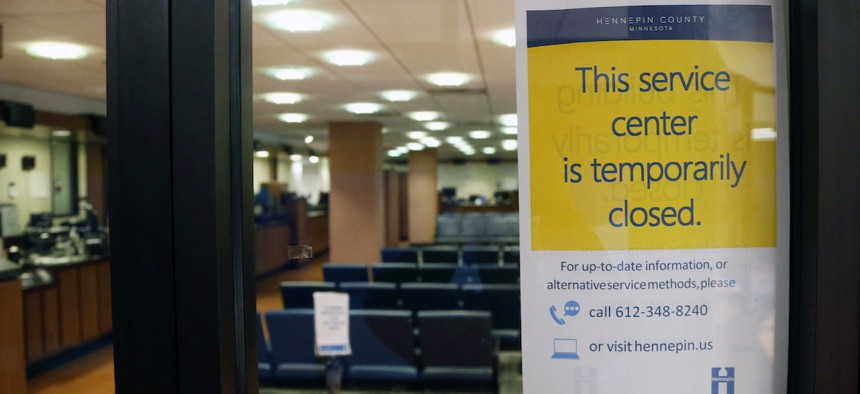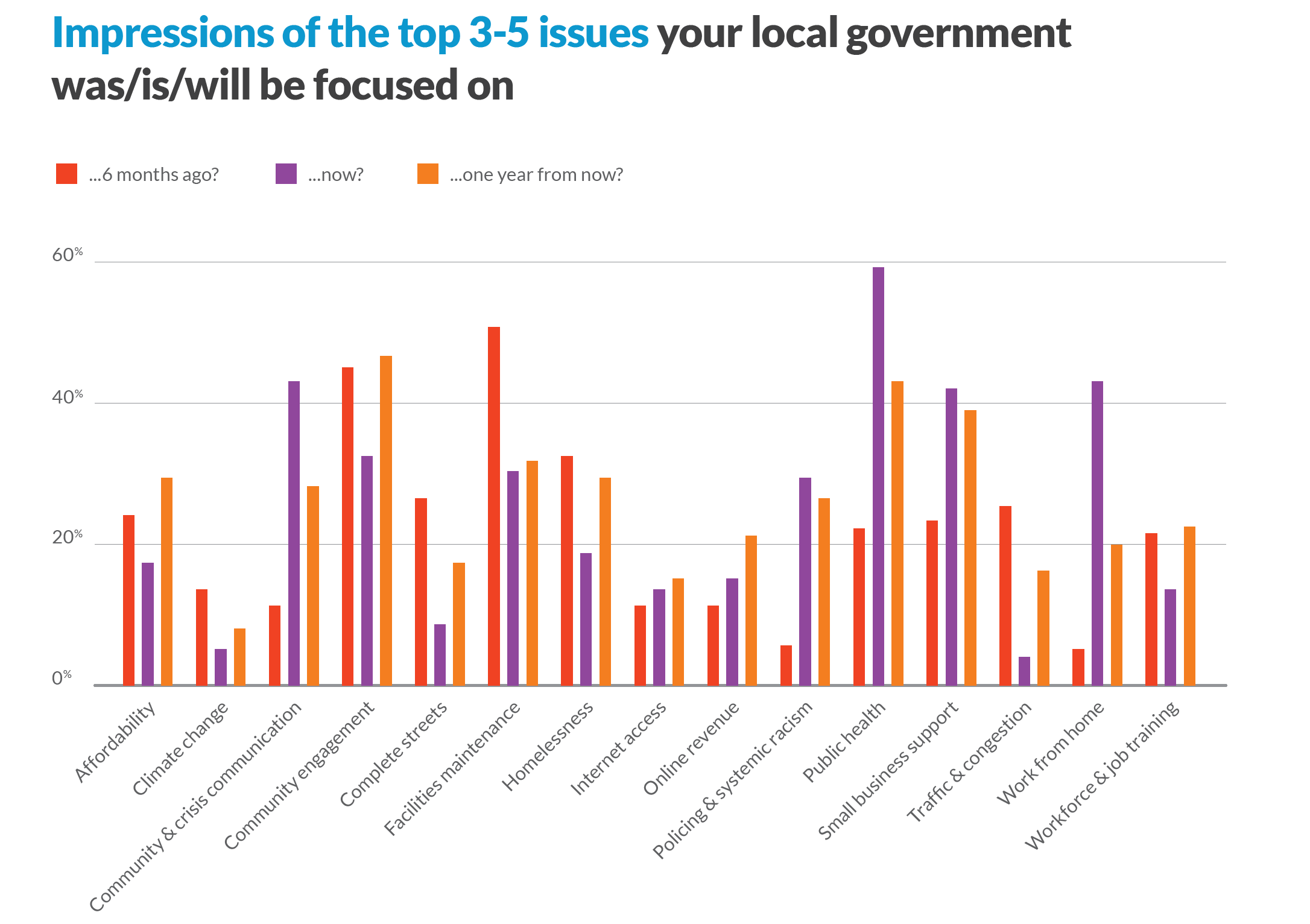Revenue Shortfalls, Low Morale and New Technology: A Survey of Government Leaders in the Age of Covid-19

The Hennepin County Government Center service center stands closed Tuesday, March 17, 2020 in Minneapolis where efforts to slow the spread of the coronavirus continue. (AP Photo/Jim Mone) Associated Press
Facing reduced tax revenues and dealing with new challenges, local government officials in a new survey by ELGL, the Atlas and SeeClickFix reflect on staff morale and potential government cutbacks, as well as the technology that is helping them navigate this time.
In McMinnville, Oregon, the ongoing Covid-19 pandemic hasn’t had catastrophic impacts on tax revenues or the city workforce. So far, there haven’t been furloughs, and layoffs were limited to part-time staffers in the parks and recreation department. But the city’s workers are still navigating isolation, stress and uncertainty, officials said, and as a result, morale is suffering.
“I sent out an all-city email back in the early part, around April, when we were all starting to figure this stuff out,” said Kylie Bayer-Fertterer, human resources manager for the northwestern Oregon city with a population of about 35,000 and a staff of roughly 175. “I think a lot of what people had been feeling was that anticipatory grief—you think something bad is happening, but you can’t place it, and it’s making you really tired. We haven’t yet seen that revenue slump that we keep hearing about in other cities, and I think that’s probably why everyone is on edge.”
Morale is low among employees in both large and small communities across the country, according to the results of a recent survey of local and state government officials. The “Local Government’s Next Normal” survey, a joint project between the Atlas, ELGL and SeeClickFix, surveyed 385 officials and staff members on the impacts of Covid-19 on public service delivery.
The vast majority said that morale within their organizations had suffered in the past six months, including 79% in municipalities with populations greater than 100,000 and 90% in smaller communities, with populations under 100,000.
“Responses from both large and small communities indicate that employees aren’t doing well,” according to the results. “Morale has been significantly impacted due to concerns about Covid, constantly changing headlines and news, and new and revised working scenarios.”
State and local leaders are worried about revenue shortfalls, which in many places have already forced government staff layoffs. U.S. Labor Department figures show that local governments' workforces had decreased by 879,000 jobs in July compared to the same month last year, with nearly half of those losses in education-related positions. A recent review of municipal fiscal conditions by the National League of Cities found that cities are expecting a 13% drop in 2021 general fund revenues compared to this year.
In the Atlas, ELGL and SeeClickFix survey, 94% of respondents are anticipating decreased tax revenue, which will force cuts in a variety of programs and functions. Asked to identify the top three areas where their governments could reduce spending, 61% expected capital projects to take a hit, while more than half expected to see personnel layoffs and furloughs and less spent on travel. A third anticipated that community programs would be cut.
.png)
But survey respondents also emphasized that the pandemic, which in March forced local governments to rapidly shift how they operate, spurred innovation. More than 95% of survey respondents said that their municipalities used software to maintain service levels even as employees started working from home, including 75% who adopted new technology to maintain community engagement and communications.
In McMinnville, that included a shift to virtual city council meetings, as well as video conferencing among employees. It’s worked to keep government functioning, Bayer-Fertterer said, but in some cases has thrown into sharper relief the feelings of loneliness and isolation among employees.
“A lot of the work we do in the public sector is direct service provision with people,” she said. “Even though city council meetings may seem boring or procedural, it’s still a chance to see your community and hear people face to face, and we don’t do that right now. That’s been a challenge for people.”
But there are silver linings to those technologies as well, said Luke Stowe, interim director of administrative services and chief information officer for the city of Evanston, Illinois. In addition to helping employees communicate directly with each other, transitioning city meetings to video or online platforms can help marginalized populations that normally find it difficult to participate in government to get involved, he said.
“We just have tons of boards and committees and commissions and city council meetings, and I hope long-term that a hybrid meeting becomes the model going forward,” he said. “I think it’s a great option for seniors, or working parents, or people who don’t want to sit at the civic center for four hours—they can connect from home, or somewhere else, and be able to join that meeting as it’s happening.”
Like other cities, Evanston, located just north of Chicago on the shore of Lake Michigan, had to pivot quickly to remote work once Covid-19 hit the area. On a Thursday in early March, the city manager asked Stowe’s team, along with the 311 team, to move their infrastructure to the cloud—and to have it done by Monday.
“Essentially overnight at least a third of our workforce had to shift to remote working,” he said. “We had a little bit of a break in Evanston because we’ve had virtual desktop infrastructure since 2013, so a lot of our workers were already familiar with that. It wasn’t a complete shock to the system. But there were a lot of cities and counties that had never allowed people to work from home, so they had to start from scratch, overnight.”

That transition is likely to be one of the shifts that remains when the pandemic has passed. Eighty percent of survey respondents said they believed the shift from paper to digital processes would be permanent, and 76% said their cities were likely to adopt more software to streamline public services. Nearly half of those respondents planned to implement new technology to further improve work from home/flexible schedules, online revenue and payment capture, and community engagement.
Stowe is hopeful that development could also signal a change in the traditional mechanisms of government, particularly when it comes to the adoption of new technologies. That process is typically slow and sometimes painstaking, but that might evolve in the future now that officials have seen that it’s possible to change tracks quickly—and successfully, he said.
“I think overall our city staff is pretty progressive and innovative, but there were definitely staffers pre-Covid who said, ‘We can’t do that digitally.’ And then Covid hit, and those same staffers are now embracing it and are fully onboard now,” he said. “It’s kind of pushed people over the digital cliff a little bit, in a good way, and that’s been a positive thing.”
Kate Elizabeth Queram is a staff correspondent for Route Fifty and is based in Washington, D.C.
NEXT STORY: Hurricane Laura Forecast to Become Category 4 Storm As Thousands Flee Gulf Coast Communities





